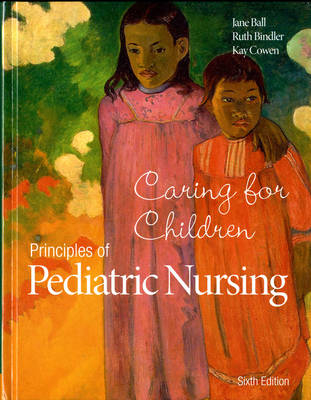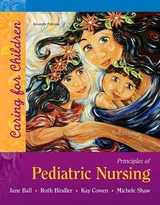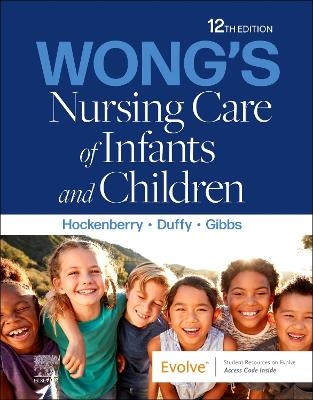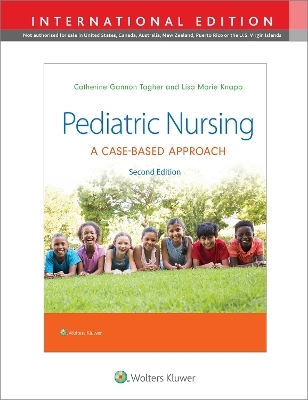
Principles of Pediatric Nursing
Pearson (Verlag)
978-0-13-389806-4 (ISBN)
- Titel erscheint in neuer Auflage
- Artikel merken
¿
Written to prepare today’s student for excellence in nursing, Principles of Pediatric Nursing presents a foundation of core pediatric nursing principles with an emphasis on growth and development, family-centered care, and health promotion and maintenance. The book integrates research, clinical reasoning, and evidence-based practice to help readers make connections between classroom and clinical situations. This edition empowers students to move beyond rote memorization of facts. Clinical reasoning and problem-solving principles helpreaders develop their clinical judgment so that they can learn to apply information as nursing practice continues to develop.
¿
Principles of Pediatric Nursing is available packaged with MyNursingLab®, an online homework, tutorial, and assessment program that engages students in learning. It helps students review, remember, and then apply key concepts–resulting in better performance in the course–and provides educators with a dynamic set of tools for gauging individual and class progress.
¿
Students, if interested in purchasing this title with MyNursingLab, ask your instructor for the correct package ISBN. Instructors, contact your Pearson representative for more information.
¿
Teaching and Learning Experience
To provide a better teaching and learning experience, for both instructors and students, this program will help:
Improve Results: MyNursingLab better prepares students for the classroom, and beyond.
Develop Clinical Reasoning Skills for Today and Tomorrow: Readers are encouraged to think creatively and critically about nursing care.
Identify the Unique Health Care Needs of Children: Children are not just “little adults”–readers will learn the important differences in provision of nursing care for children versus adults, as well as the health conditions that children commonly experience.
Visualize Health Conditions: Real photos help bring important concepts to life.
¿
Note: You are purchasing the standalone text. MyNursingLab does not come automatically packaged with the text.
Jane W. Ball graduated from the Johns Hopkins Hospital School of Nursing, and subsequently received a BS from the Johns Hopkins University. She began her nursing career working in the pediatric surgical inpatient, emergency department, and outpatient clinic of the Johns Hopkins Medical Center, first as a staff nurse and then as a pediatric nurse practitioner. After recognizing a need to focus on the health of children she returned to school and obtained both a master of public health and a doctor of public health degree from the Johns Hopkins University Bloomberg School of Public Health with a focus on maternal and child health. After graduation Dr. Ball became the chief of child health services for the Commonwealth of Pennsylvania Department of Health. In this capacity she oversaw the state-funded well-child clinics and explored ways to improve education for the state’s community health nurses. After relocating to Texas, she joined the faculty at the University of Texas at Arlington School of Nursing to teach community pediatrics to registered nurses returning to school for a BSN. During this time she became involved in writing her first textbook, Mosby’s Guide to Physical Examination, which is currently in its eighth edition. After relocating to the Washington, DC, area, she worked at Children’s National Medical Center on a number of federally funded projects. The first project in 1986, teaching instructors of emergency medical technicians from all states about the special care children need during an emergency revealed the shortcomings of the emergency medical services system for children. This exposure was a career-changing event. A textbook entitled Pediatric Emergencies, A Manual for Prehospital Providers was subsequently developed. A second project led to the development of a pediatric emergency education program for nurses in emergency departments to promote improved care for children. Both of these programs served as a foundation for other pediatric emergency education developed and sponsored by national organizations. For 15 years Dr. Ball managed the federally funded Emergency Medical Services for Children’s National Resource Center. As executive director, she provided and directed the provision of consultation and resource development for state health agencies, health professionals, families, and advocates about successful methods to improve the health care system so that children get optimal emergency care in all health care settings. After leaving that position, she continues to be engaged in many projects with a focus on the emergency care system. She is a consultant to the American College of Surgeons Committee on Trauma, supporting state trauma system development. She recently completed a federally funded project to study whether the implementation of a statewide pediatric emergency department recognition program improved pediatric emergency care. In 2010, Dr. Ball received the Distinguished Alumna Award from the Johns Hopkins University. Ruth C. McGillis Bindler received her BSN from Cornell University—New York Hospital School of Nursing. She worked in oncology nursing at Memorial-Sloan Kettering Cancer Center in New York, and then a public health nurse in Dane County, Wisconsin. Thus began her commitment to work with children as she visited children and their families at home, and served as a school nurse. Due to this interest in child health care needs, she earned her MS in child development from the University of Wisconsin. A move to Washington State was accompanied by a new job as a faculty member at the Intercollegiate Center for Nursing Education in Spokane. Dr. Bindler was fortunate to be involved for over 38 years in the growth of this nursing education consortium, which is a combination of public and private universities and colleges and is now the Washington State University (WSU) College of Nursing. Ruth obtained a PhD in human nutrition at WSU. She taught theory and clinical courses in child health nursing, cultural diversity and health, graduate research, pharmacology, and assessment, as well as serving as lead faculty for child health nursing. She was the first Director of the PhD in Nursing program at WSU and most recently served as Associate Dean for Graduate Programs, which include Master of Nursing, Post-Masters certificates, PhD and Doctor of Nursing Practice (DNP) programs. She recently retired and serves the college and profession as a professor emeritus, continuing work with graduate students and research. Her first professional book, Pediatric Medications, was published in 1981, and she has continued to publish articles and books in the areas of pediatric medications and pediatric health. Research foci have been childhood obesity, type 2 diabetes, metabolic syndrome, and cardiometabolic risk factors in children. Ethnic diversity and interprofessional collaboration have been additional themes in her work. Dr. Bindler believes that her role as a faculty member and administrator enabled her to learn continually, foster the development of students in nursing, lead and mentor junior faculty into the teaching role, and participate fully in the profession of nursing. In addition to teaching, research, publication, and leadership, she enhances her life by professional and community service, and by activities with her family. Kay J. Cowen received her BSN from East Carolina University in Greenville, North Carolina, and began her career as a staff nurse on the pediatric unit of North Carolina Baptist Hospital in Winston-Salem. She developed a special interest in the psychosocial needs of hospitalized children and preparing them for hospitalization. This led to the focus of her master’s thesis at the University of North Carolina at Greensboro (UNCG) where she received a master of science in nursing education degree with a focus in maternal child nursing. Mrs. Cowen began her teaching career in 1984 at UNCG where she continues today as clinical professor in the Parent Child Department. Her primary responsibilities include coordinating the pediatric nursing course, teaching classroom content, and supervising a clinical group of students. Mrs. Cowen shared her passion for the psychosocial care of children and the needs of their families through her first experience as an author in the chapter “Hospital Care for Children” in Jackson & Saunders’ Child Health Nursing: A Comprehensive Approach to the Care of Children and Their Families published in 1993. In the classroom, Mrs. Cowen realized that students learn through a variety of teaching strategies and became especially interested in the strategy of gaming. She led a research study to evaluate the effectiveness of gaming in the classroom and subsequently continues to incorporate gaming in her teaching. In the clinical setting, Mrs. Cowen teaches her students the skills needed to care for patients and the importance of family-centered care, focusing on not only the physical needs of the child but also the psychosocial needs of the child and family. During her teaching career, Mrs. Cowen has continued to work part time as a staff nurse: first on the pediatric unit of Moses Cone Hospital in Greensboro and then at Brenner Children’s Hospital in Winston-Salem. In 2006 she became the part-time pediatric nurse educator in Brenner’s Family Resource Center. Through this role she is able to extend her love of teaching to children and families. Through her role as an author, Mrs. Cowen is able to extend her dedication to pediatric nursing and nursing education.
Nurse’s Role in Care of the Child
Family-Centered Care and Cultural Considerations
Genetic and Genomic Influences
Growth and Development
Pediatric Assessment
Introduction to Health Promotion and Maintenance
Health Promotion and Maintenance for the Newborn and Infant
Health Promotion and Maintenance for the Toddler and Preschooler
Health Promotion and Maintenance for the School-Age Child and Adolescent
Nursing Considerations for the Child in the Community
The Hospitalized Child
The Child with a Chronic Condition
The Child with a Life-Threatening Condition and End-of-Life Care
Infant, Child, and Adolescent Nutrition
Pain Assessment and Management
Immunizations and Communicable Diseases
Assessment and Management of Social and Environmental Influences
Alterations in Fluid, Electrolyte, and Acid—Base Balance
Alterations in Eye, Ear, Nose, and Throat Function
Alterations in Respiratory Function
Alterations in Cardiovascular Function
Alterations in Immune Function
Alterations in Hematologic Function
The Child with Cancer
Alterations in Gastrointestinal Function
Alterations in Genitourinary Function
Alterations in Neurologic Function
Alterations in Mental Health and Cognition
Alterations in Musculoskeletal Function
Alterations in Endocrine and Metabolic Function
Alterations in Skin Integrity
Appendix A: Physical Growth Charts
Appendix B: Blood Pressure Tables
Appendix C: Recommended Dietary Allowances
Appendix D: Normal Laboratory Values
Appendix E: Diagnostic Tests and Procedures
Appendix F: Body Surface Nomogram
Appendix G: Temperature and Weight Conversion
| Erscheint lt. Verlag | 13.11.2014 |
|---|---|
| Sprache | englisch |
| Maße | 222 x 278 mm |
| Gewicht | 2340 g |
| Themenwelt | Medizin / Pharmazie ► Pflege ► Kinderkrankenpflege |
| ISBN-10 | 0-13-389806-7 / 0133898067 |
| ISBN-13 | 978-0-13-389806-4 / 9780133898064 |
| Zustand | Neuware |
| Haben Sie eine Frage zum Produkt? |
aus dem Bereich



